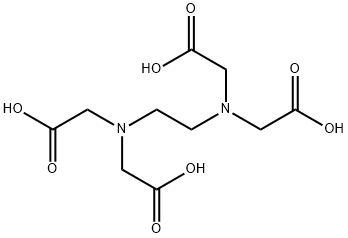ETHYLENEDIAMINETETRAACETIC DIANHYDRIDE
Synonym(s):4,4′-Ethylenebis(2,6-morpholinedione);EDTA dianhydride
- CAS NO.:23911-25-3
- Empirical Formula: C10H12N2O6
- Molecular Weight: 256.21
- MDL number: MFCD00074963
- SAFETY DATA SHEET (SDS)
- Update Date: 2025-01-27 09:38:02

What is ETHYLENEDIAMINETETRAACETIC DIANHYDRIDE?
The Uses of ETHYLENEDIAMINETETRAACETIC DIANHYDRIDE
Ethylenediaminetetraacetic Acid Dianhydride (A-EDTA) is used as a reagent in the synthesis of a new class of polymer, poly-2.6-piperazinedione. A-EDTA is also used in the synthesis of EDTA functionalized polyacrylnitriles (PANs) by direct reaction with amine and hydroxyl functionalized polyacrylnitrile.
General Description
Ethylenediaminetetraacetic dianhydride (EDTAD) is a ramification of ethylenediaminetetraacetate (EDTA), which consists of two anhydride groups that can react with the hydroxyl and the amino groups. It is a biodegradable compound that is used as a chelating agent.
Properties of ETHYLENEDIAMINETETRAACETIC DIANHYDRIDE
| Melting point: | 190 °C (dec.) (lit.) |
| Boiling point: | 489.5±45.0 °C(Predicted) |
| Density | 1.449 |
| storage temp. | under inert gas (nitrogen or Argon) at 2-8°C |
| solubility | DMSO, Methanol |
| form | Solid |
| pka | 2.06±0.20(Predicted) |
| color | Pale Beige |
Safety information for ETHYLENEDIAMINETETRAACETIC DIANHYDRIDE
| Signal word | Warning |
| Pictogram(s) |
 Exclamation Mark Irritant GHS07 |
| GHS Hazard Statements |
H315:Skin corrosion/irritation H319:Serious eye damage/eye irritation H335:Specific target organ toxicity, single exposure;Respiratory tract irritation |
| Precautionary Statement Codes |
P261:Avoid breathing dust/fume/gas/mist/vapours/spray. P264:Wash hands thoroughly after handling. P264:Wash skin thouroughly after handling. P271:Use only outdoors or in a well-ventilated area. P280:Wear protective gloves/protective clothing/eye protection/face protection. P302+P352:IF ON SKIN: wash with plenty of soap and water. P305+P351+P338:IF IN EYES: Rinse cautiously with water for several minutes. Remove contact lenses, if present and easy to do. Continuerinsing. |
Computed Descriptors for ETHYLENEDIAMINETETRAACETIC DIANHYDRIDE
| InChIKey | POLIXZIAIMAECK-UHFFFAOYSA-N |
New Products
Indole Methyl Resin tert-butyl 9-methoxy-3-azaspiro[5.5]undecane-3-carboxylate Boc-His(Boc)-OH 2-CTC Resin 4-Chloro-7-tosy1-7Hpyrrolo[2,3-d]pyrimidine 5,7-Dibromo-1H-indole 2,5-dichloro-N-hydroxy-4,6-dimethylpyridine-3-carboximidamide 2,2-Dimethoxy-7-azaspiro[3.5]nonane hydrochloride 4-chloromethyl-5-methyl-1,3-dioxol-2-one (DMDO-Cl) R-2-BENZYLOXY PROPIONIC ACID 1,1’-CARBONYLDIIMIDAZOLE 1,1’-CARBONYLDI (1,2-4 TRIAZOLE) N-METHYL INDAZOLE-3-CARBOXYLIC ACID 4-((2-hydroxyethyl)thio)benzoic acid 1-(TERT-BUTOXYCARBONYL)-2-PYRROLIDINONE Methyl 6-methylnicotinate 3-Pyridineacrylic acid tert-Butyl carbazate TETRAHYDRO-2H-PYRAN-3-OL 2-((4-morpholinophenylamino) (methylthio) methylene) malononitrile 3-(4-morpholinophenylamino)-5-amino-1H-pyrazole-4-carbonitrile 2,4-dihydroxybenzaldehyde 1,3-Diethyl-1,3-Diphenylurea Methyl 2-methylquinoline-6-carboxylateRelated products of tetrahydrofuran








You may like
-
 Ethylenediaminetetraacetic dianhydride 95% CAS 23911-25-3View Details
Ethylenediaminetetraacetic dianhydride 95% CAS 23911-25-3View Details
23911-25-3 -
 Ethylenediaminetetraacetic Dianhydride CAS 23911-25-3View Details
Ethylenediaminetetraacetic Dianhydride CAS 23911-25-3View Details
23911-25-3 -
 Ethylenediaminetetraacetic dianhydride CAS 23911-25-3View Details
Ethylenediaminetetraacetic dianhydride CAS 23911-25-3View Details
23911-25-3 -
 Pyridine 99.5% HPLC /UV SpectroscopyView Details
Pyridine 99.5% HPLC /UV SpectroscopyView Details
110-86-1 -
 Piperazine Spot supply, best priceView Details
Piperazine Spot supply, best priceView Details
110-85-0 -
 Dibutyl PhthalateView Details
Dibutyl PhthalateView Details
84-74-2 -
 Imidazole Spot supply, competitive priceView Details
Imidazole Spot supply, competitive priceView Details
288-32-4 -
 Thiourea 99% ARView Details
Thiourea 99% ARView Details
62-56-6
Statement: All products displayed on this website are only used for non medical purposes such as industrial applications or scientific research, and cannot be used for clinical diagnosis or treatment of humans or animals. They are not medicinal or edible.
